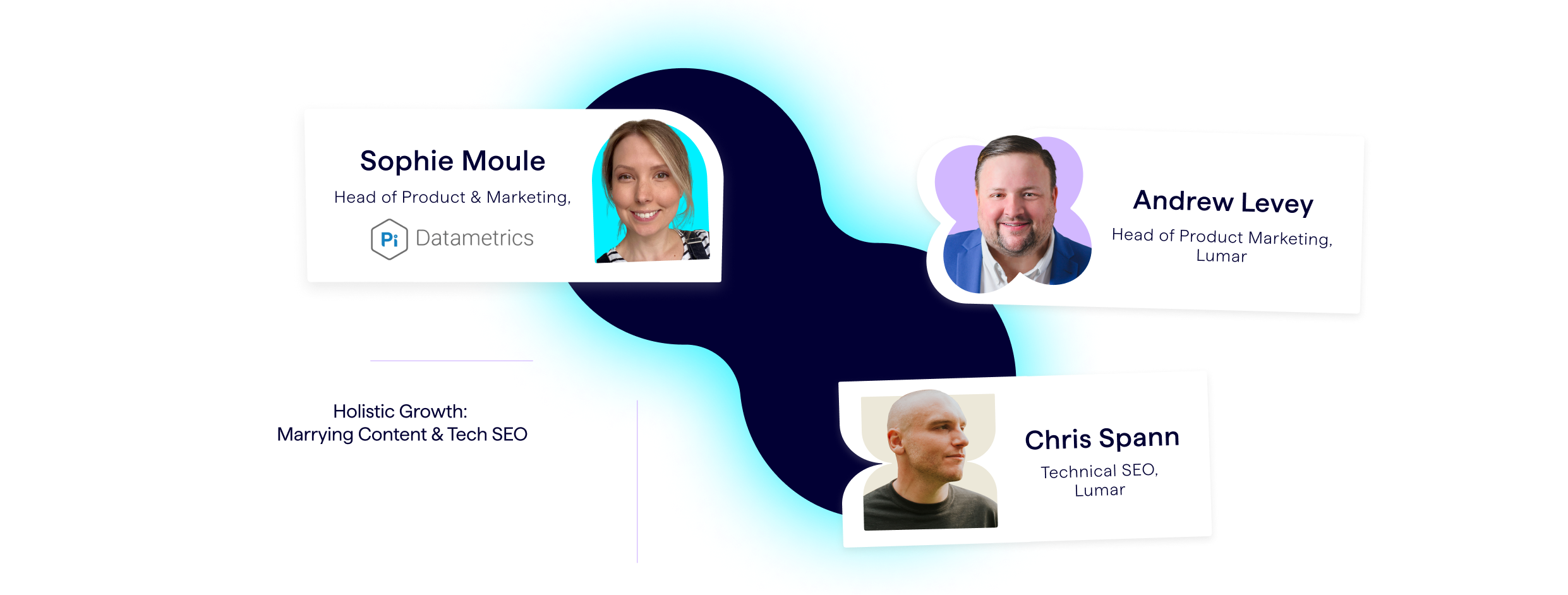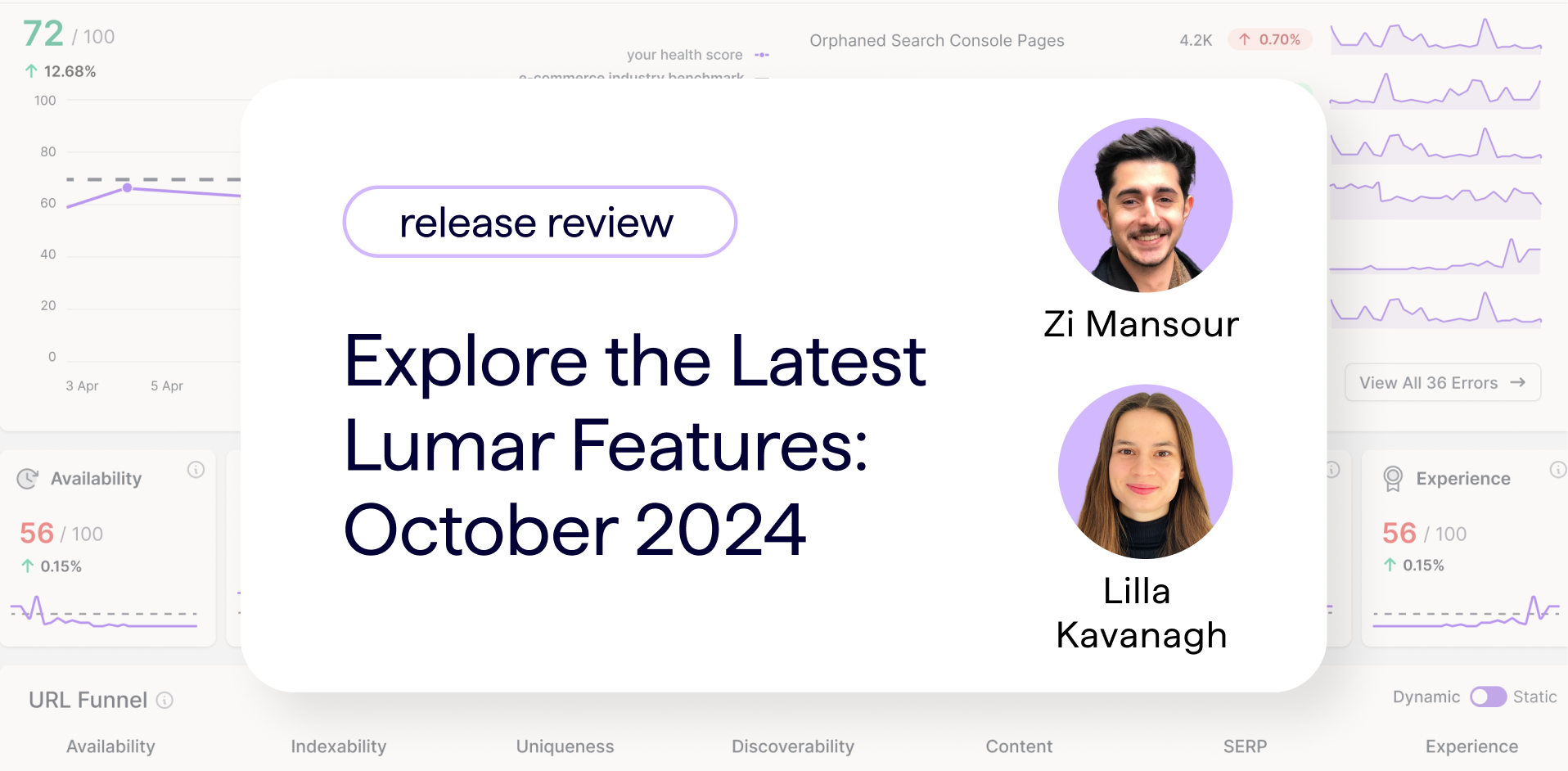The latest Lumar webinar session focuses on how to blend content and technical efforts for maximum SEO impact. Watch the full webinar (including Q&A) above, or read on for our key takeaways.
Host Andrew Levey is joined by senior technical SEO, Chris Spann, of Lumar’s SEO professional services team and Sophie Moule, head of product and marketing at Pi Datametrics. With their deep knowledge of technical SEO and website content, they are a veritable dream team to help guide businesses that are seeking to reap the benefits of holistic search engine optimization strategies.
Anyone working on websites knows that both content and technical SEO are crucial for ranking well in organic search. Both areas contribute to user experience and engagement and drive brand awareness and revenue by helping to get your site to the top of the SERPs. So how can SEOs and digital marketers best prioritize tasks, monitor performance, and identify growth opportunities across both types of SEO?
If you’re ready to better align your content and tech SEO efforts and maximize search-driven growth more holistically, this is the webinar to watch!
Why website pros need to marry content with technical SEO
In short, combining content efforts with strong technical SEO strategies gives your website pages their best shot at ranking well in search engine results, helping drive brand awareness and organic growth.
Without technical optimization, your website’s content —however great it may be!— may not be fully accessible for search engines to crawl, index, rank, and deliver to users in their search results. On the other hand, website content plays a significant role in increasing the website’s perceived authority and relevance, which is also crucial for achieving higher search engine rankings. A combination of both technical SEO and great content is necessary for holistic SEO success, leading to increased organic traffic and revenue.
How to effectively prioritize technical SEO improvements
“If Google can’t find, access, or index your content, it doesn’t matter how good it is, it won’t get seen [in organic search],” explained Lumar’s Chris Spann.
His recommended first step to effectively prioritize your site’s technical health is to undertake an SEO audit.
“First things first, you need a toolset you can trust,” he says.
These SEO tools should include:
- A website crawler (like Lumar)
- Backlink and internal link data
- Website traffic analytics
- Google Search Console
- Keyword tools
But gathering insights from a site audit is just one piece of the puzzle. You’ll likely find quite a few areas for improvement when you audit your site’s technical health, meaning you’ll need to prioritize which improvements to tackle first. Spann suggests using an effort/impact matrix to help prioritize technical SEO tasks.
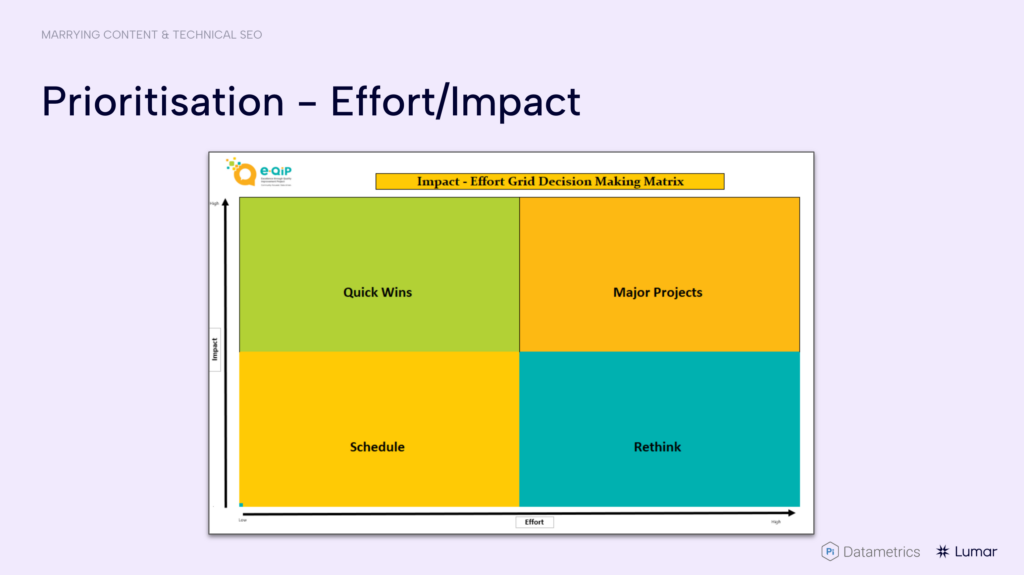
- LOW effort / HIGH impact — These are quick wins — you’ll likely want to get these tech SEO tasks done as quickly as possible!
- LOW effort / LOW impact — Schedule these tasks. Make these low-effort, low-impact SEO projects a regular occurrence so they don’t get lost in the shuffle and ignored indefinitely — and so they don’t build up so much that they eventually become high-impact mistakes.
- HIGH effort / LOW impact — Realistically, these tasks will end up on the back burner, to be addressed during quieter times of the year when workloads are lower across the board due to the number of resources required despite the relatively low expected impact.
- HIGH effort / HIGH impact — These are major projects. These larger-scale but highly impactful tasks will often require additional planning and may require SEOs to actively petition leadership to get the buy-in and resources to execute on these tasks.
Spann also notes that the Lumar platform provides website health scores and traffic funnel visualizations that can be very helpful for SEOs seeking to better prioritize their technical SEO tasks (and helpful for petitioning leadership for extra resources!).

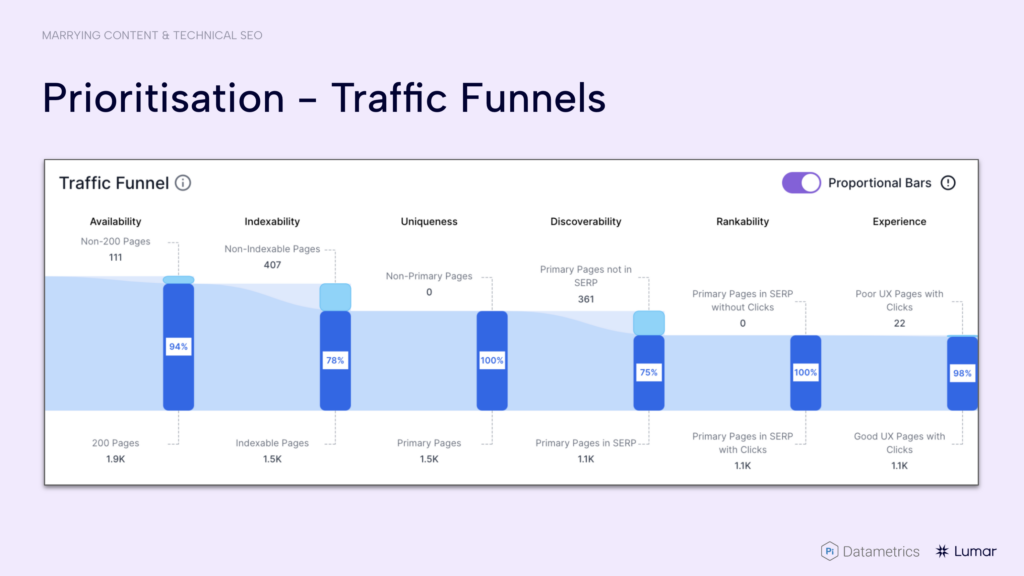
How to prioritize website content opportunities
For Pi Datametrics’ Sophie Moule, prioritization is also critical when it comes to website content.
“More than ever, I think, it’s important to really prioritize,” she says. “A good way to prioritize what you are going to be working on from an impact point of view is what’s going to give you the highest commercial return.”
Moule offers four tips to help prioritize your content projects:
- Keep your customer front of mind
- Think about the multiple doorways to your website
- Identify high-revenue opportunities
- Communicate progress at a high level
Keep your customer front of mind when planning content
When it comes to keeping the customer front of mind, Moule suggests using trend data to understand what customers are interested in and planning your content accordingly.
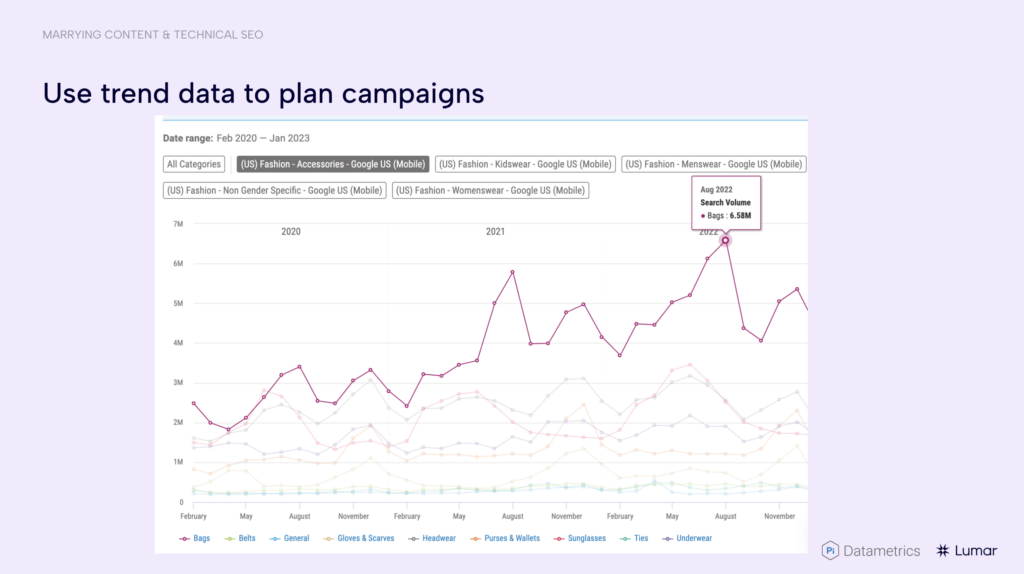
“The reason I really love trend data is because, if you can identify these patterns, you can start planning your content calendar going around some of these things,” she says.
Moule also suggests harvesting context and intent insights from Google’s ‘People Also Ask’ feature.
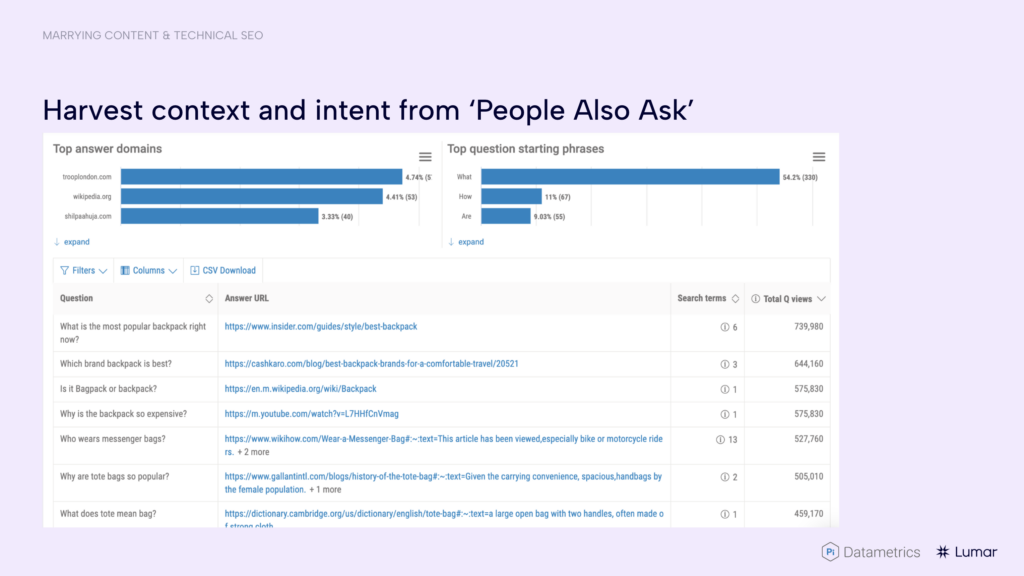
“When you think of commercial SEO, it’s really easy to land people straight on product pages and focus on getting people as quickly as possible to those product pages,” Moule says.
“But when we’ve researched this with a variety of different customers,” she continues, “we’ve found that if you land a potential customer on an informational page instead of a product page they’re more likely to convert on your website, to have a higher average order value, and to have higher loyalty as a customer.”
Consider all possible gateways to your website: utilize the entire SERP landscape
Moule also advises content SEOs to utilize the entire SERP landscape when planning content. This can help you create more doorways through which potential customers might enter your site.
When thinking about the multiple doors to your website, she points to the rise of the ‘popular products’ feature in the SERPs. These give you more real estate on page 1 of the search results and for certain products, they really can be the gateway to your site for users.
“We all know that long gone are the days of Google being a long list of blue ‘classic’ links. Google is rich with multiple SERP features. So when you’re creating your content, it’s important to identify opportunities not just for traditional long-form content, but for all the different SERP features that Google’s presenting for those different types of search terms.”
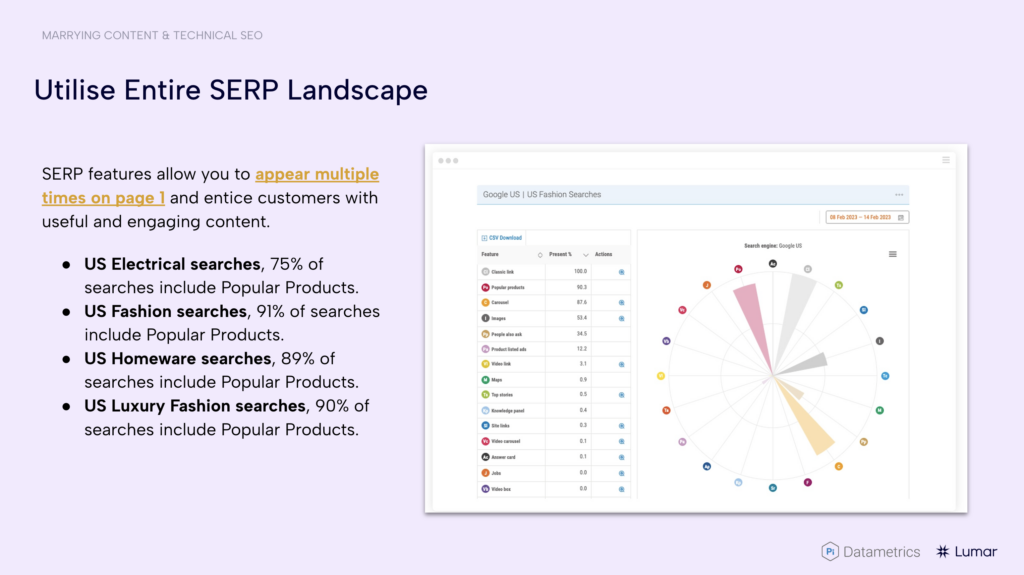
For example, according to Moule’s data, a massive 91% of US fashion-related searches include ‘popular products’ results.
Spann added that this is one example of where technical SEO can really connect nicely to content efforts, by ensuring you have the right structured data, or schema markup, in place on your web pages to qualify for these enhanced SERP features in Google.
Identify topics that offer the highest commercial return
For Moule, content SEOs also need to be asking: which categories/topics offer the highest return?
Of course, certain search terms may drive more traffic than others, but some more focused longer-tail phrases may drive higher commercial returns.
“CMOs and senior management don’t speak the same language that SEOs speak,” she says. “So anything you can do to apply a monetary value to some of the work you are doing is really important and can help with some of that buy-in.”
Moule points to the example of ‘blonde hair’ as a high-traffic term, whereas ‘blonde hair dye’ would drive more commercial return. With the Pi Datametrics platform, it is possible to overlay estimated revenue potential onto your search traffic data to really visualize which terms, categories, or topics should be prioritized on your site.
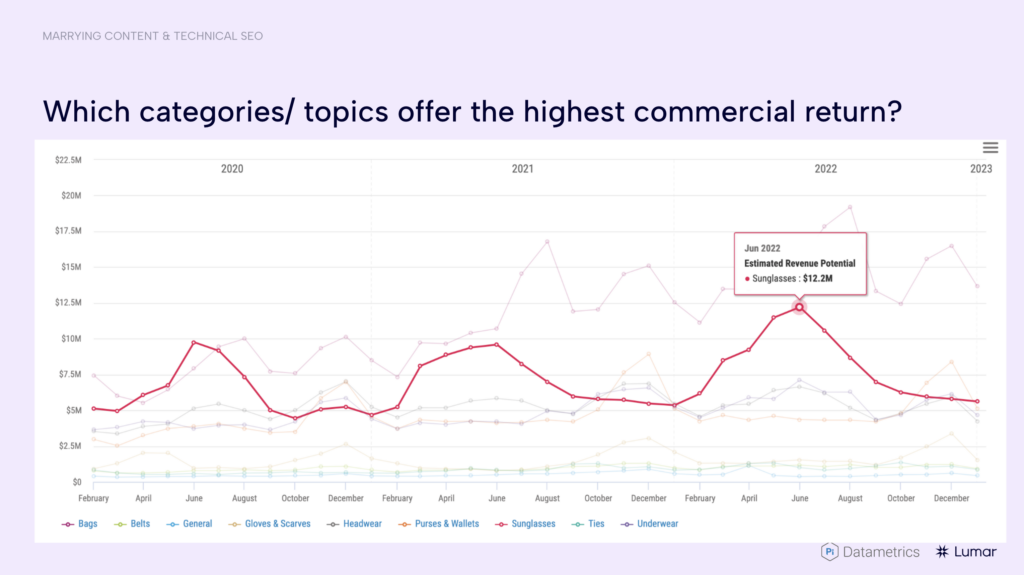
Keep an eye on your existing content
Moule also points to the importance of keeping an eye on existing content that might be ranking on pages two or three of the search results, but with relatively little work could be pushed further up the rankings.
“Like Chris and I were just talking about, you’ve created the content, you’ve got it ranking on page two or three, but there are just some additional things you may need to do from a technical perspective, or a content perspective, that could bump it up the search results and help you get that commercial return.”
Moule also recommends keeping an eye on keyword cannibalization if you notice some pages being stuck lower down in the rankings:
“One of the biggest reasons websites have that glass ceiling of ranking isn’t because their competitors are taking up space, it’s because they themselves are competing with their own URLs, so they have different conflicting URLS,” she says. “Monitoring the conflict health of your website is a really great thing to do.”
Improving internal linking and addressing competing URLs within your own domain can be quick wins for your pages that are lagging in the search rankings and can lead to some strong results straight away.
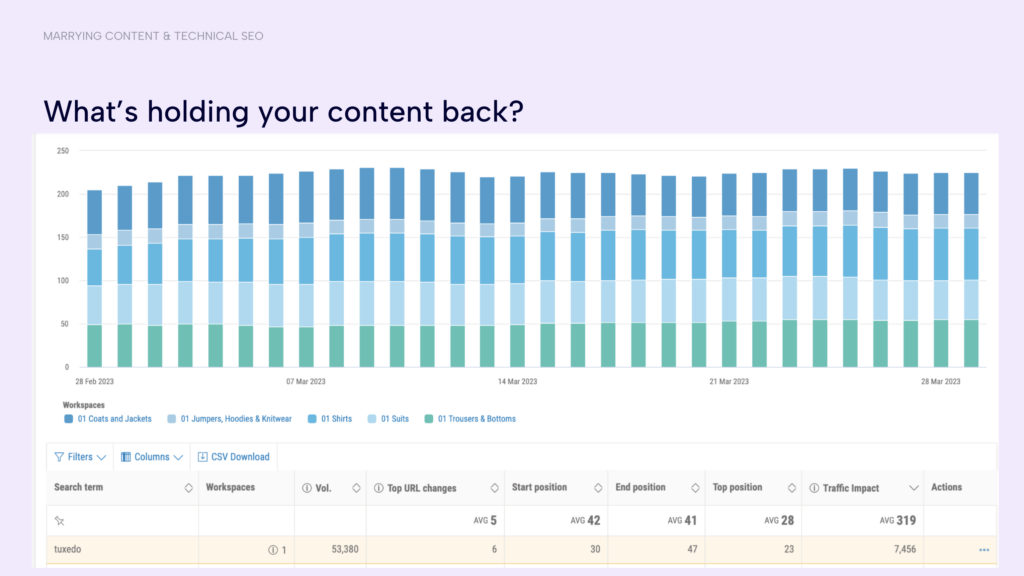
Communicate content SEO progress with good reporting
Finally, when it comes to communicating content SEO progress at a higher level, Moule refers to the oft-cited mantra: If you can’t measure it, you can’t manage it.
“Making sure that you have a really good reporting setup is crucial to make sure that you’re maximizing commercial opportunities,” Moule says.
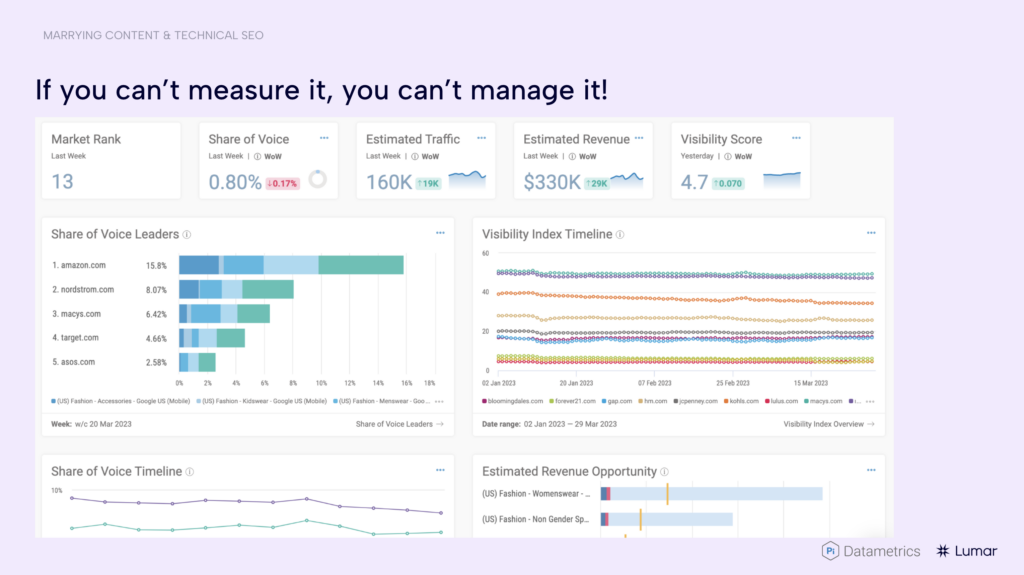
She also advises that content SEOs measure organic share of voice:
“A metric we use among senior stakeholders that really pricks their ears up is share of voice.”
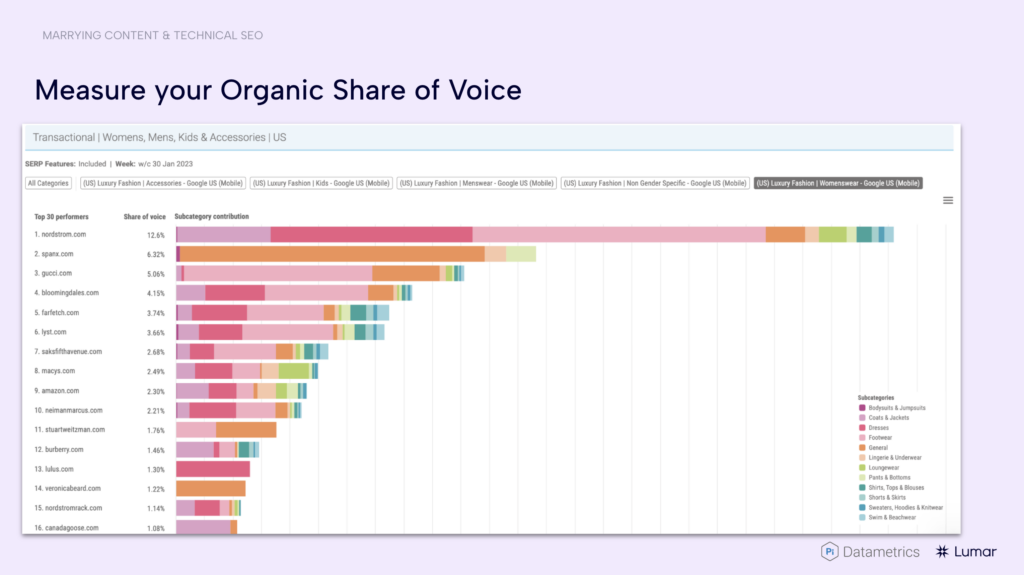
When measuring share of voice metrics, Moule suggests breaking things down by sub-category as well, so you can see exactly where competitors might be outperforming you in terms of their content and find out which topics or products you may want to focus your efforts on more.
Content SEO tools
Looking to improve your website content and better understand what topics to prioritize? Check out the robust content platform offered by Pi Datametrics.
Technical SEO tools
Ready to improve your technical SEO efforts to drive your content up in the search engine rankings? Give Lumar’s website intelligence platform a try — book a personalized platform demo today.
